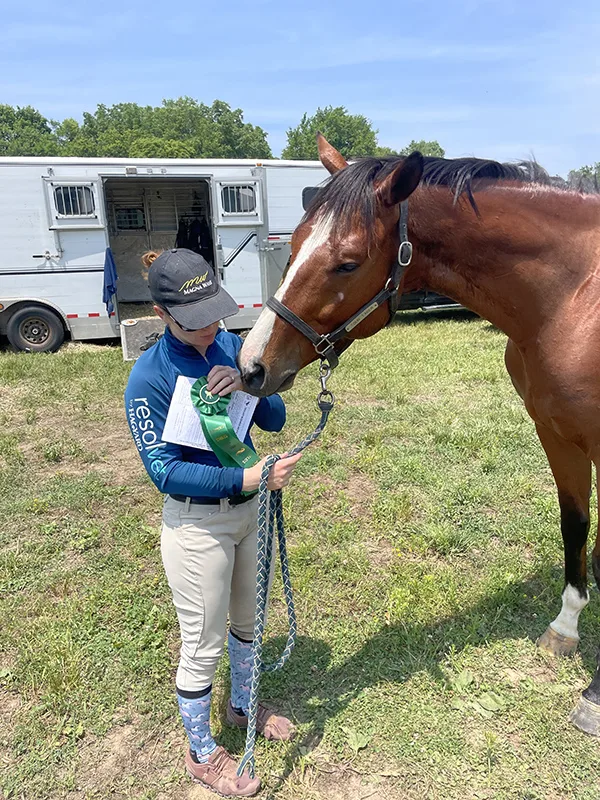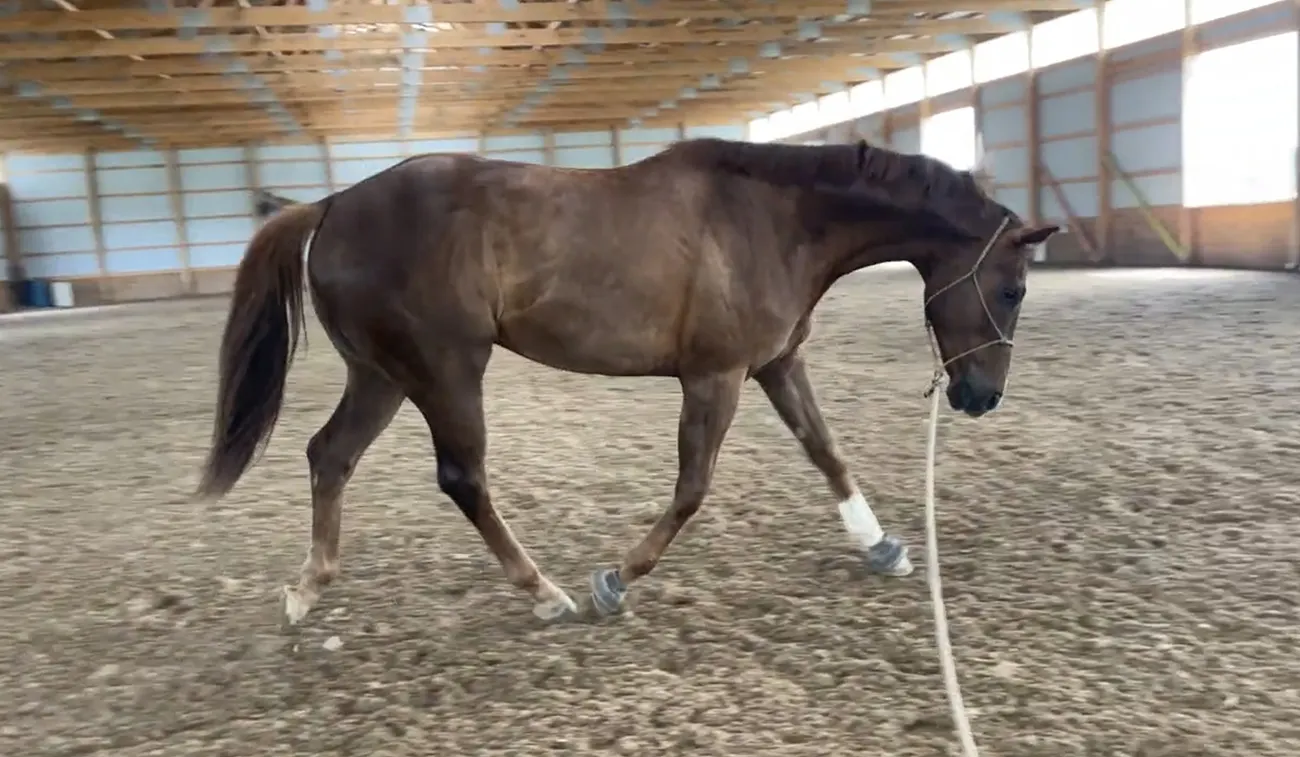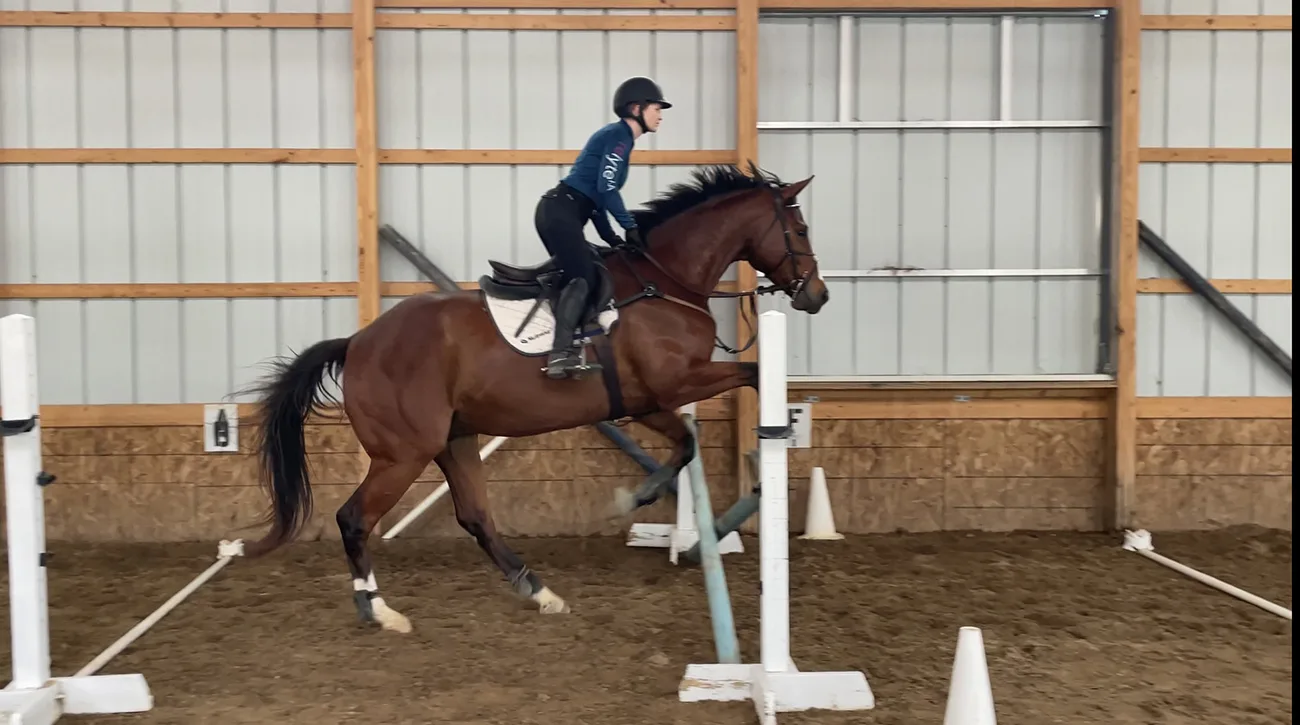While we enjoy the excitement of taking baby Thoroughbreds to their first horse shows and celebrate their progress at this point in the “Road to the Makeover,” there’s one factor just about anybody training a horse knows is crucial, and that is the value of going slow. In one way or another, if you’re training baby Thoroughbreds, they will teach you patience. The time since my last blog has been much less “how to teach a baby horse to jump” and a bit more “let’s just be thorough.”
Both of the 4-year-olds I have headed toward the Makeover, Sam and Hank (learn more about them here), are big and young. In the world of resale, they’re truly what everybody is after. However, big, immature horses go through distinct phases, both mentally and physically.
Sam has rehabbed a tendon injury and been castrated, and along with simply transitioning off the track in general, that means both his body and his whole world have experienced plenty of change. Being so big and growing as a 4-year-old is a lot for a horse’s body to endure in less than a year. Bodywork is an essential part of getting from point A to point Z. It takes a team effort amongst my vet, farrier, dentist, chiropractor, ortho-bionomy practitioner, as well as managing saddle fit, to help him through the changes as he grows. After having almost a year to just sit around and eat grass, Sam has had a big job of getting stronger, especially in his core. Sam’s chiropractor adjustments and ortho-bionomy sessions suggest that we’ve definitely made changes through his topline.

Backing Off With Sam
After his first time showing at a three-phase event, where we saw the mental side of the experience challenge him more than the physical, Sam (Jockey Club name Sacred Samurai) returned to flatwork at home. Because he is clearly going through a huge growth spurt (as if he needed to get any bigger), we have asked him to do a bit less in the most recent couple of weeks while we give his body a break. He also scraped himself in turn-out and ended up with an infection that required antibiotics.
While he recovered, we’ve back off of ridden work and found other ways to help him progress.
Instead of being ridden on weekly hacks, which involve walking up and down hills, over, under and through all of the things, he has experienced all that while being ponied off of other horses. This keeps him moving and thinking without putting any stress on his body.
Groundwork too is another aspect of training that is always beneficial and we can use during his down time. With July around the corner, we’re getting closer to the Makeover, but there is absolutely no rush with this horse. He already has a good foundation to go along with a great brain, and there will be lots of schooling opportunities for him coming up in the next few months.
“Take the time it takes and it takes less time,” horseman Tom Dorrance was known to say. We’re giving Sam plenty of time to heal and grow into himself.
ADVERTISEMENT

That said, I’m looking forward to getting Sam going again after backing off of his training for a bit. He is definitely a horse who is worth the wait.
Meanwhile Hank (Jockey Club name Tour Taker) has made a lot of mental progress. He has become a thinker under saddle. Since his first horse show, we’ve come back to a lot of flatwork with Hank. He has amazing jumping form already—he is bold and brave and loves jumping—so the better I can get him on the flat, the easier his progress will be over fences. With such a huge jump, rideability will really be important.
It always amazes me how horses go from basics to basics to basics, and then it seems like the last couple of weeks before the Makeover everything seems to fall into place, and they are set up perfectly for the big show! The important thing to remember is to always have faith in the process.
Focusing On Balance And Straightness
Relating to the process, one of my favorite flatwork exercises to help a green horse learn to balance himself is to make a large figure-8, the size of my entire arena, and ask him to stay on the large circle, flexed to the inside, using only an open inside rein (no outside rein) and inside leg. I’m careful to keep my eye up and on the outside of each circle, and I keep my outside leg back to keep the hind end in line. To change direction, I use a big lateral half-halt before the change of bend, then I switch the side of the aids as I change directions. I’m careful to keep my eye up and on the outside of each circle. To be able to do this exercise, the horse must have a very good understanding of a half-halt from your seat and your leg (no hands), and also he must know how to effectively move off your inside leg as well as hold his own balance by maintaining engagement of the inside hind leg.
If the horse does not truly understand how to effectively move away from your leg, you can imagine your circle will get quite small. The challenge for the rider is staying tall and straight (don’t lean in!) while resisting the urge to use their outside rein to pull the horse toward the outside of the circle. To help with this I use a yoke. A yoke is a piece of racing equipment that is like a neck strap but also attaches to the girth between the front legs like a breastplate or martingale would. I prefer this over a neck strap because of where and how it sits on the horse’s neck. Holding the outside hand on the yoke can help the rider keep their balance, which is helpful to the horse and also prevents the use of the outside hand on the rein. If the horse is looking to the rider to catch his balance then he will start to fall in on the circle.
Instead of “saving” the horse (from losing his balance), if you leave it up to him to balance himself while your inside leg encourages his inside hind leg to step underneath him, he will learn to become accountable for his own balance. And you may be thinking about the most common expression in dressage, “inside leg to OUTSIDE REIN!” but you would not be accurately riding inside leg to outside rein if he doesn’t actually understand how to move away from your inside leg. This exercise breaks it down to one step at a time to show the horse how to balance himself. I’ll periodically go back to this exercise to make sure I am being accountable for how correctly I am riding my horse and how well he is responding to my aids.
Another topic I focus on at this point in a young horse’s training is straightness. Hank’s physical challenge relate to his symmetry and using himself evenly in his hind end. As this ginormous horse grows like a weed, he continues to change. Horses generally tend to show weakness on one side, but also they tend to show less coordination on one side. It becomes more challenging when those are the same side. Think about being right- or left-handed, except you’re not given a choice which hand you learn to write with. (Thoroughbreds at the track in the United States are always galloping to the left.) Once a horse starts to straighten out throughout their transition off the track, it’s not uncommon for them to switch “good sides.”

Whether its coordination or weakness, a horse will naturally do less when they feel less comfortable. Straightness is one of the hardest things for OTTBs to achieve because of their lack of guidance in that area when they are broke and initially trained at the track.
ADVERTISEMENT
They also train one direction in the trot (or sometimes in the infamous “trainer”) and the other direction in a gallop. And those factors apply even before taking into consideration any previous injuries that could also contribute to a physical imbalance. To complete a successful rehab you must develop straightness. That has been my main focus with Hank, and he is making progress in becoming straighter and holding his own balance while learning to stretch and move more through from hind end to front end. There’s still a long way to go, but he’s starting to love the work.
Hank Shines At His Horse Trials
With his newfound work ethic, Hank earned himself another entry at a local mini-trial. He jumped two times between the two mini-trials that he’s completed, once being a course and the other being a gymnastics exercise the day before the event.
It’s the rideability, which comes from the flatwork, that contributes to how the horse jumps a course. The gymnastics was to remind him and further his belief that his power in jumping comes from a squat. At the show, Hank was jumping so big that I was worried about how the course would go considering it was in a relatively small arena.
We don’t necessarily have the rideability to jump a training level course, yet that’s about the height Hank jumped each fence in warm-up. When he entered the ring though, you can absolutely see his ticker ticking. He reads everything and does his best to listen to my aids. He finished on his dressage score, which included an error that was intentionally executed to recover from a baby moment, and he brought home another ribbon!
I have a special affection for Hank, and I’m enjoying this journey with him even more than with most other horses. Hank tends to acquire a fan base wherever he goes because of his good looks and his impressive movement, but he is also a total ham and a complete goofball.
Rosie Napravnik is a former jockey who holds multiple riding titles throughout the country, is a two-time winner of the Kentucky Oaks, the only female jockey to win multiple Breeder’s Cup races and the only female to ride in all three Triple Crown races. Retired from racing since 2014, Rosie lives in Simpsonville, Kentucky, with her husband, Joe Sharp, and their three children. Rosie runs a private Thoroughbred rehab and retraining operation, Off-Track Sporthorses, from the family’s Four Ponds Farm. Rosie has also created a boutique lesson program for kids, advocating for kids learning more than what an arena has to offer.














